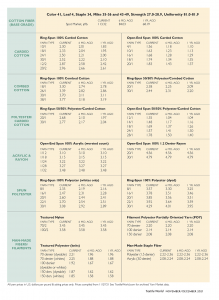 By Jim Phillips, Yarn Market Editor
By Jim Phillips, Yarn Market Editor
Manufacturing activity increased in November as the overall economy continued to grow for the 18th consecutive month, according to the Institute for Supply Management (ISM) Report on Business®.
According to the December 1 ISM report, the 11 industries reporting growth in production during the month of November — listed in order — are: Petroleum and coal products; textile mills; furniture and related products; paper products; electrical equipment, appliances and components; computer and electronic products; machinery; chemical products; miscellaneous manufacturing; food, beverage and tobacco products; and plastics and rubber products.
Exports Also Increasing
The exports of textile and apparel from the United States increased by 20.15 percent in the first nine months of 2021, as compared to the same period a year ago, according to data from the U.S. Department of Commerce Office of Textiles and Apparel (OTEXA). Among textile mill products, yarn exports increased by 26.09 percent year-on-year to $2.902 billion, while fabric exports were up 15.79 percent to $6.451 billion and made-up and miscellaneous article exports grew 12.92 percent to $3.011 billion.
The value of exports stood at $16.75 billion during January-September 2021, compared to $13.941 billion in the same period last year, according OTEXA.
Category-wise, apparel exports increased by 28.94 per cent year-on-year to $4.385 billion, while textile mill products rose 17.31 per cent to $12.365 billion during the first nine months of 2021.
Mexico and Canada together accounted for nearly half of the total U.S. textile and clothing exports during the period under review. The United States supplied $4.726 billion worth of textiles and apparel to Mexico during the nine-month period, followed by $3.911 billion to Canada and $1.051 billion to Honduras.
Historically, textile and clothing exports have remained in the range of $22 billion to $25 billion per year. In 2019, for example, exports for the year totaled $22.905 billion. The effects of the global COVID-19 pandemic, however, caused the value of exports in 2020 to fall to $19.330 billion for the year.
Sustainability
Yarn Market first reported on the eventual need for sustainability and traceability programs more than a decade ago. Back then, conversations about those issues were primarily concentrated in the agriculture and consumer products segments. But, even in the mid-2000s it was becoming clear that sustainability and traceability would eventually become priorities for any industry that manufactured components for products that would eventually be sold to consumers.
Today, the United States has become a world leader in sustainability.
In late November, Unifi Inc. announced a major milestone. The company has now transformed more than 30 billion post-consumer plastic bottles into its REPREVE® recycled performance fibers that are used by hundreds of the world’s leading brands.
“Our brand and mill partners helped us achieve this ambitious goal,” said Unifi CEO Eddie Ingle.
“By making the switch to sustainable by choosing to use Repreve, we’ve been able to keep more than 30 billion plastic bottles out of landfills. We want to thank consumers for choosing to buy products — ranging from apparel to home furnishings to shoes — made with Repreve. Together, we are working today for the good of tomorrow.”
Unifi began setting recycling goals in 2017 after hitting the 10 billion bottle milestone. The company pledged to transform 20 billion bottles by 2020 and 30 billion bottles by 2022. However, the company reached its 30-billion- bottle goal a year early.
To put this achievement into perspective:
- When Unifi launched Repreve, it was initially adopted by only two brands; now, more than 1,000 brands world-wide use the recycled performance fibers.
- Repreve fiber sales are approaching 40 percent of Unifi’s total sales, with that number expected to continue to grow in the coming year.
- 30 billion bottles used to create Repreve fiber, instead of the virgin equivalent, can save enough energy to power nearly 284,000 homes in the United States for one year.
November/December 2021





